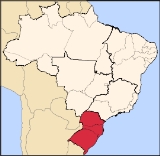
Southern Region, Brazil
Encyclopedia
The South Region of Brazil is one of the five regions of Brazil. It includes the states of Paraná
, Santa Catarina
and Rio Grande do Sul
and covers 576,409.6 km ², being the smallest portion of the country. It is a great tourist
, economic
and cultural
pole.
It borders Uruguay
, Argentina
, and Paraguay
as well as the Center-West Region
, the Southeast Region
and the Atlantic Ocean.
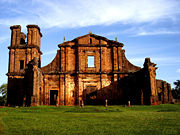 By the time the first European explorers arrived, all parts of the territory were inhabited by semi-nomadic Indian tribes, who subsisted on a combination of hunting, fishing, gathering, and agriculture.
By the time the first European explorers arrived, all parts of the territory were inhabited by semi-nomadic Indian tribes, who subsisted on a combination of hunting, fishing, gathering, and agriculture.
and Spanish
Jesuits. They lived among the Indians and made them become Catholics. Colonists from São Paulo
(Bandeirantes) arrived in the same period. For decades, the Portuguese and Spanish crowns disputed over this region. Due to this conflict, the King of Portugal encouraged the immigration of settlers from the Azores Islands to Southern Brazil. Between 1748 and 1756, six thousand Azoreans arrived. They composed over half of the population of Rio Grande do Sul and Santa Catarina by the late 18th century.
 Soon after Brazil's independence from Portugal (1822), the first Germans came to Brazil. Settlers from Germany were brought to work as small farmer
Soon after Brazil's independence from Portugal (1822), the first Germans came to Brazil. Settlers from Germany were brought to work as small farmer
s, because there were many land holdings without workers. To attract the immigrants, the Brazilian government had promised large tracts of land, where they could settle with their families and colonize the region. The first immigrants arrived in 1824, settling in the city of São Leopoldo
. In the next five decades, another 28 thousand Germans were brought to Rio Grande do Sul to work as small farmers in the countryside. By 1914, it is estimated that 50 thousand Germans had settled in this state.
In Santa Catarina, most German immigrants were not brought by the Brazilian government, but by private groups, such as the Hamburg
Colonization Society, which were promoting the immigration of Europeans to the Americas
. They created rural communities or colonies to these immigrants. Many of these German colonies had a great development and became large cities, such as Blumenau
and Joinville
, the largest city in Santa Catarina.
Considerable numbers of immigrants from Germany arrived at Paraná
during the 1870s, most of them coming from Santa Catarina
or Volga German
s from Russia.
an uprising that began in Southern Brazil (Rio Grande do Sul
and Santa Catarina
) in 1835. The rebels, led by generals Bento Gonçalves da Silva
and Antônio de Souza Netto with the support of the Italian warrior Giuseppe Garibaldi
, surrendered to imperial forces in 1845. This conflict occurred because in Rio Grande do Sul, the state's main product, the charque (bovine dried and salted meat), suffered the hard competition of charque from Uruguay
and Argentina
, which had free access to the Brazilian market while the gaucho
s had to pay high taxes inside Brazil. The Italian revolutionary Giuseppe Garibaldi
joined the rebels in 1839. With his help the revolution spread through Santa Catarina
, in the northern border of Rio Grande do Sul. After many conflicts, in 1845 the peace negotiations finished with the war.
 Italian immigrants started arriving in Brazil in 1875. They were mostly peasant
Italian immigrants started arriving in Brazil in 1875. They were mostly peasant
s from the Veneto
, but also from Trentino and Lombardia, Northern Italy
. They were attracted to Southern Brazil to get their own lands and populate the South. Most of the immigrants worked as small farmers, mainly cultivating grape
s in the Serra Gaúcha
. Italian immigration to the region lasted until 1914, with a total of 100 thousand Italians settling in Rio Grande do Sul in this period and many others in Santa Catarina and Paraná.
In 1898, there were 300 thousand people of Italian origin
in Rio Grande do Sul, 50 thousands in Santa Catarina and 30 thousands in Paraná. Nowadays, their Southern Brazilian descendants are 9.7 million, composing 35.9% of Southern Brazil's population.
during the 19th century, who have had a large influence on its demography and culture. The main ethnic origins of Southern Brazil are Portuguese
, Italian, and German
.
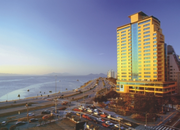
Telephone
s: 6,919,000 (April/2007);
Cities: 1,188 (2007).
It's the only Brazilian Region with an organized separatist movement, known as "O Sul é o Meu País
" (Portuguese: The South is My Country), or Pátria Sulista (Portuguese: Southern Fatherland).
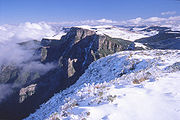 Southern Brazil has subtropical
Southern Brazil has subtropical
or temperate climate. The annual average temperatures vary between 12°C (53.6°F) and 22°C (71.6°F). It can snow in the mountain ranges.
, like Curitiba
and Maringá
. It has a relatively high standard of living, with the highest Human Development Index
of Brazil, 0.859 (2007), and the second highest per capita income of the country, $13.396, behind only the Southeast Region. The region also has a 94% literacy rate.
 Portuguese, the official language of Brazil, is spoken by the entire population. In the south countryside, dialects of German or Italian origins are also spoken. The predominant dialects are the Hunsrückisch
Portuguese, the official language of Brazil, is spoken by the entire population. In the south countryside, dialects of German or Italian origins are also spoken. The predominant dialects are the Hunsrückisch
and the Venetian
(or Talian
). In Rio Grande do Sul
and Curitiba
there are some Yiddish speakers. In the northern region of Paraná
there are Japanese speakers. There are Polish language and Ukrainian language speakers in Paraná as well,.
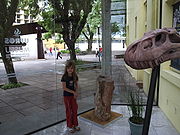 The Rio Grande do Sul
The Rio Grande do Sul
has a great potential for palaeontological
tourism, with many paleontological sites and museums in Paleorrota
. There is a large area in the center of the state that belongs to the Triassic
. Here lived Rhynchosaur
, thecodont
s, exaeretodon
s, Staurikosaurus
, Guaibasaurus
, Saturnalia tupiniquim, Sacisaurus
, Unaysaurus
and many others.
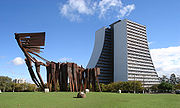
Paraná (state)
Paraná is one of the states of Brazil, located in the South of the country, bordered on the north by São Paulo state, on the east by the Atlantic Ocean, on the south by Santa Catarina state and the Misiones Province of Argentina, and on the west by Mato Grosso do Sul and the republic of Paraguay,...
, Santa Catarina
Santa Catarina (state)
Santa Catarina is a state in southern Brazil with one of the highest standards of living in Latin America. Its capital is Florianópolis, which mostly lies on the Santa Catarina Island. Neighbouring states are Rio Grande do Sul to the south and Paraná to the north. It is bounded on the east by...
and Rio Grande do Sul
Rio Grande do Sul
Rio Grande do Sul is the southernmost state in Brazil, and the state with the fifth highest Human Development Index in the country. In this state is located the southernmost city in the country, Chuí, on the border with Uruguay. In the region of Bento Gonçalves and Caxias do Sul, the largest wine...
and covers 576,409.6 km ², being the smallest portion of the country. It is a great tourist
Tourism
Tourism is travel for recreational, leisure or business purposes. The World Tourism Organization defines tourists as people "traveling to and staying in places outside their usual environment for not more than one consecutive year for leisure, business and other purposes".Tourism has become a...
, economic
Economy of Brazil
The economy of Brazil is the world's seventh largest by nominal GDP and eighth largest by purchasing power parity. Brazil has moderately free markets and an inward-oriented economy...
and cultural
Culture of Brazil
The culture of Brazil presents a very diverse nature reflecting an ethnic and cultural mixing occurred in the colonial period involving mostly Native Americans, Portuguese and Africans...
pole.
It borders Uruguay
Uruguay
Uruguay ,officially the Oriental Republic of Uruguay,sometimes the Eastern Republic of Uruguay; ) is a country in the southeastern part of South America. It is home to some 3.5 million people, of whom 1.8 million live in the capital Montevideo and its metropolitan area...
, Argentina
Argentina
Argentina , officially the Argentine Republic , is the second largest country in South America by land area, after Brazil. It is constituted as a federation of 23 provinces and an autonomous city, Buenos Aires...
, and Paraguay
Paraguay
Paraguay , officially the Republic of Paraguay , is a landlocked country in South America. It is bordered by Argentina to the south and southwest, Brazil to the east and northeast, and Bolivia to the northwest. Paraguay lies on both banks of the Paraguay River, which runs through the center of the...
as well as the Center-West Region
Center-West Region, Brazil
The Central-West Region of Brazil is composed of the states of Goiás, Mato Grosso and Mato Grosso do Sul; along with Distrito Federal , where Brazil's national capital, Brasília, is situated...
, the Southeast Region
Southeast Region, Brazil
The Southeast Region of Brazil is composed by the states of Espírito Santo, Minas Gerais, Rio de Janeiro and São Paulo. It is the richest region of the country, responsible for approximately 60% of the Brazilian GDP. São Paulo, Rio de Janeiro and Minas Gerais are three richest states of Brazil,...
and the Atlantic Ocean.
Pre-Columbian History

Portuguese colonization
European colonization in Southern Brazil started with the arrival of PortuguesePortuguese people
The Portuguese are a nation and ethnic group native to the country of Portugal, in the west of the Iberian peninsula of south-west Europe. Their language is Portuguese, and Roman Catholicism is the predominant religion....
and Spanish
Spanish people
The Spanish are citizens of the Kingdom of Spain. Within Spain, there are also a number of vigorous nationalisms and regionalisms, reflecting the country's complex history....
Jesuits. They lived among the Indians and made them become Catholics. Colonists from São Paulo
São Paulo
São Paulo is the largest city in Brazil, the largest city in the southern hemisphere and South America, and the world's seventh largest city by population. The metropolis is anchor to the São Paulo metropolitan area, ranked as the second-most populous metropolitan area in the Americas and among...
(Bandeirantes) arrived in the same period. For decades, the Portuguese and Spanish crowns disputed over this region. Due to this conflict, the King of Portugal encouraged the immigration of settlers from the Azores Islands to Southern Brazil. Between 1748 and 1756, six thousand Azoreans arrived. They composed over half of the population of Rio Grande do Sul and Santa Catarina by the late 18th century.
German settlement

Farmer
A farmer is a person engaged in agriculture, who raises living organisms for food or raw materials, generally including livestock husbandry and growing crops, such as produce and grain...
s, because there were many land holdings without workers. To attract the immigrants, the Brazilian government had promised large tracts of land, where they could settle with their families and colonize the region. The first immigrants arrived in 1824, settling in the city of São Leopoldo
São Leopoldo
São Leopoldo is an important Brazilian industrial city located in the south state of Rio Grande do Sul. It occupies a total area of 103.9 km² at circa 30 km from the State Capital, Porto Alegre. Climate is sub-tropical, with temperatures varying from 2°C minimum at Winter to more than...
. In the next five decades, another 28 thousand Germans were brought to Rio Grande do Sul to work as small farmers in the countryside. By 1914, it is estimated that 50 thousand Germans had settled in this state.
In Santa Catarina, most German immigrants were not brought by the Brazilian government, but by private groups, such as the Hamburg
Hamburg
-History:The first historic name for the city was, according to Claudius Ptolemy's reports, Treva.But the city takes its modern name, Hamburg, from the first permanent building on the site, a castle whose construction was ordered by the Emperor Charlemagne in AD 808...
Colonization Society, which were promoting the immigration of Europeans to the Americas
Americas
The Americas, or America , are lands in the Western hemisphere, also known as the New World. In English, the plural form the Americas is often used to refer to the landmasses of North America and South America with their associated islands and regions, while the singular form America is primarily...
. They created rural communities or colonies to these immigrants. Many of these German colonies had a great development and became large cities, such as Blumenau
Blumenau
Blumenau is a city in Vale do Itajaí, state of Santa Catarina, in southern Brazil. It was founded on September 2, 1850 by Dr. Hermann Bruno Otto Blumenau along with 17 German immigrants. A few years later Fritz Müller migrated to Blumenau as well....
and Joinville
Joinville
Joinville is a city in Santa Catarina State, in the Southern Region of Brazil. Joinville is Santa Catarina's largest city. In 2010, its population has reached approximately 520,000, many of whom are of German descent....
, the largest city in Santa Catarina.
Considerable numbers of immigrants from Germany arrived at Paraná
Paraná (state)
Paraná is one of the states of Brazil, located in the South of the country, bordered on the north by São Paulo state, on the east by the Atlantic Ocean, on the south by Santa Catarina state and the Misiones Province of Argentina, and on the west by Mato Grosso do Sul and the republic of Paraguay,...
during the 1870s, most of them coming from Santa Catarina
Santa Catarina (state)
Santa Catarina is a state in southern Brazil with one of the highest standards of living in Latin America. Its capital is Florianópolis, which mostly lies on the Santa Catarina Island. Neighbouring states are Rio Grande do Sul to the south and Paraná to the north. It is bounded on the east by...
or Volga German
Volga German
The Volga Germans were ethnic Germans living along the River Volga in the region of southern European Russia around Saratov and to the south. Recruited as immigrants to Russia in the 18th century, they were allowed to maintain German culture, language, traditions and churches: Lutherans, Reformed,...
s from Russia.
War of Tatters
The War of Tatters was a RepublicRepublic
A republic is a form of government in which the people, or some significant portion of them, have supreme control over the government and where offices of state are elected or chosen by elected people. In modern times, a common simplified definition of a republic is a government where the head of...
an uprising that began in Southern Brazil (Rio Grande do Sul
Rio Grande do Sul
Rio Grande do Sul is the southernmost state in Brazil, and the state with the fifth highest Human Development Index in the country. In this state is located the southernmost city in the country, Chuí, on the border with Uruguay. In the region of Bento Gonçalves and Caxias do Sul, the largest wine...
and Santa Catarina
Santa Catarina (state)
Santa Catarina is a state in southern Brazil with one of the highest standards of living in Latin America. Its capital is Florianópolis, which mostly lies on the Santa Catarina Island. Neighbouring states are Rio Grande do Sul to the south and Paraná to the north. It is bounded on the east by...
) in 1835. The rebels, led by generals Bento Gonçalves da Silva
Bento Gonçalves da Silva
General Bento Gonçalves da Silva, , was a Tatter Revolutionary leader and President of the Piratini Republic ....
and Antônio de Souza Netto with the support of the Italian warrior Giuseppe Garibaldi
Giuseppe Garibaldi
Giuseppe Garibaldi was an Italian military and political figure. In his twenties, he joined the Carbonari Italian patriot revolutionaries, and fled Italy after a failed insurrection. Garibaldi took part in the War of the Farrapos and the Uruguayan Civil War leading the Italian Legion, and...
, surrendered to imperial forces in 1845. This conflict occurred because in Rio Grande do Sul, the state's main product, the charque (bovine dried and salted meat), suffered the hard competition of charque from Uruguay
Uruguay
Uruguay ,officially the Oriental Republic of Uruguay,sometimes the Eastern Republic of Uruguay; ) is a country in the southeastern part of South America. It is home to some 3.5 million people, of whom 1.8 million live in the capital Montevideo and its metropolitan area...
and Argentina
Argentina
Argentina , officially the Argentine Republic , is the second largest country in South America by land area, after Brazil. It is constituted as a federation of 23 provinces and an autonomous city, Buenos Aires...
, which had free access to the Brazilian market while the gaucho
Gaucho
Gaucho is a term commonly used to describe residents of the South American pampas, chacos, or Patagonian grasslands, found principally in parts of Argentina, Uruguay, Southern Chile, and Southern Brazil...
s had to pay high taxes inside Brazil. The Italian revolutionary Giuseppe Garibaldi
Giuseppe Garibaldi
Giuseppe Garibaldi was an Italian military and political figure. In his twenties, he joined the Carbonari Italian patriot revolutionaries, and fled Italy after a failed insurrection. Garibaldi took part in the War of the Farrapos and the Uruguayan Civil War leading the Italian Legion, and...
joined the rebels in 1839. With his help the revolution spread through Santa Catarina
Santa Catarina (state)
Santa Catarina is a state in southern Brazil with one of the highest standards of living in Latin America. Its capital is Florianópolis, which mostly lies on the Santa Catarina Island. Neighbouring states are Rio Grande do Sul to the south and Paraná to the north. It is bounded on the east by...
, in the northern border of Rio Grande do Sul. After many conflicts, in 1845 the peace negotiations finished with the war.
Italian settlement

Peasant
A peasant is an agricultural worker who generally tend to be poor and homeless-Etymology:The word is derived from 15th century French païsant meaning one from the pays, or countryside, ultimately from the Latin pagus, or outlying administrative district.- Position in society :Peasants typically...
s from the Veneto
Veneto
Veneto is one of the 20 regions of Italy. Its population is about 5 million, ranking 5th in Italy.Veneto had been for more than a millennium an independent state, the Republic of Venice, until it was eventually annexed by Italy in 1866 after brief Austrian and French rule...
, but also from Trentino and Lombardia, Northern Italy
Northern Italy
Northern Italy is a wide cultural, historical and geographical definition, without any administrative usage, used to indicate the northern part of the Italian state, also referred as Settentrione or Alta Italia...
. They were attracted to Southern Brazil to get their own lands and populate the South. Most of the immigrants worked as small farmers, mainly cultivating grape
Grape
A grape is a non-climacteric fruit, specifically a berry, that grows on the perennial and deciduous woody vines of the genus Vitis. Grapes can be eaten raw or they can be used for making jam, juice, jelly, vinegar, wine, grape seed extracts, raisins, molasses and grape seed oil. Grapes are also...
s in the Serra Gaúcha
Serra Gaúcha
The Serra Gaúcha, The Gaucho Highlands, is the mountainous region in the northeastern portion of Rio Grande do Sul state in southern Brazil. This mountainous region is home to many Brazilians of German and Italian descent...
. Italian immigration to the region lasted until 1914, with a total of 100 thousand Italians settling in Rio Grande do Sul in this period and many others in Santa Catarina and Paraná.
In 1898, there were 300 thousand people of Italian origin
Italian diaspora
The term Italian diaspora refers to the large-scale migration of Italians away from Italy in the period roughly beginning with the unification of Italy in 1861 and ending with the Italian economic miracle in the 1960s...
in Rio Grande do Sul, 50 thousands in Santa Catarina and 30 thousands in Paraná. Nowadays, their Southern Brazilian descendants are 9.7 million, composing 35.9% of Southern Brazil's population.
Demographics
The region received large numbers of European immigrantsImmigration to Brazil
Immigration to Brazil is the movement to Brazil of foreign persons to reside permanently. It should not be confused with the colonisation of the country by the Portuguese, or with the forcible bringing of people from Africa as slaves....
during the 19th century, who have had a large influence on its demography and culture. The main ethnic origins of Southern Brazil are Portuguese
Portuguese-Brazilian
Portuguese Brazilians are Brazilian citizens whose ancestry originates wholly or partly in Portugal. Most of the Portuguese arrived throughout the centuries to Brazil, sought economic opportunities...
, Italian, and German
German-Brazilian
A German Brazilian is a Brazilian person of ethnic German ancestry or origin...
.

| City | State | Population (2007) |
|---|---|---|
| Curitiba Curitiba Curitiba is the capital of the Brazilian state of Paraná. It is the largest city with the biggest economy of both Paraná and southern Brazil. The population of Curitiba numbers approximately 1.75 million people and the latest GDP figures for the city surpass US$61 billion according to... |
 Paraná (state) Paraná (state) |
1,828,092 |
| Porto Alegre Porto Alegre Porto Alegre is the tenth most populous municipality in Brazil, with 1,409,939 inhabitants, and the centre of Brazil's fourth largest metropolitan area . It is also the capital city of the southernmost Brazilian state of Rio Grande do Sul. The city is the southernmost capital city of a Brazilian... |
 Rio Grande do Sul Rio Grande do Sul |
1,441,554 |
| Londrina Londrina Londrina is a city located in the northern region of the state of Paraná, Brazil, and is 369 km away from the capital, Curitiba. Londrina was originally founded by British settlers. The city exerts great influence on Paraná and Brazil's south region... |
 Paraná (state) Paraná (state) |
505,184 |
| Joinville Joinville Joinville is a city in Santa Catarina State, in the Southern Region of Brazil. Joinville is Santa Catarina's largest city. In 2010, its population has reached approximately 520,000, many of whom are of German descent.... |
 Santa Catarina (state) Santa Catarina (state) |
487,003 |
| Caxias do Sul Caxias do Sul Caxias do Sul is a city in Rio Grande do Sul, Southern Brazil, situated in the state's mountainous Serra Gaúcha region. Coordinates: 29°10′0″ S, 51°11′0″ W.... |
 Rio Grande do Sul Rio Grande do Sul |
419,852 |
| Florianópolis Florianópolis -Climate:Florianópolis experiences a warm humid subtropical climate, falling just short of a true tropical climate. The seasons of the year are distinct, with a well-defined summer and winter, and characteristic weather for autumn and spring. Frost is infrequent, but occurs occasionally in the winter... |
 Santa Catarina (state) Santa Catarina (state) |
416,564 |
| Pelotas Pelotas Pelotas is a Brazilian city and municipality , the third most populous in the southern state of Rio Grande do Sul. Pelotas is located 270 km from Porto Alegre, the capital city of the state, and 130 km from the Uruguayan border... |
 Rio Grande do Sul Rio Grande do Sul |
350,358 |
| Canoas Canoas Canoas , which won city status in 1939, is the fourth largest city in the state of Rio Grande do Sul, Brazil. Its population is over 300,000 people. The city is adjacent to the capital of the gaúcho state: Porto Alegre... |
 Rio Grande do Sul Rio Grande do Sul |
333,322 |
| Maringá Maringá Maringá is a city in southern Brazil that was founded on May 10, 1947. Maringá is the third largest city in the state of Paraná. The city has a population of 357,117 , 612,617 in its metropolitan area... |
 Paraná (state) Paraná (state) |
324,397 |
| Foz do Iguaçu Foz do Iguaçu Foz do Iguaçu is the 7th largest city in Paraná state, Brazil, with a population of 255,900 inhabitants. It is located approximately 650 km west of Curitiba, Parana's capital city, being the westernmost city in that state... |
 Paraná (state) Paraná (state) |
309,113 |
| Ponta Grossa Ponta Grossa Ponta Grossa is a city in the state of Paraná, Brazil. With a population of over 315,000 inhabitants, it is the 4th most populous city of Paraná.It is the second industrial pole of the State, exceeded only by Curitiba—the State's capital and largest city... |
 Paraná (state) Paraná (state) |
304,973 |
Trivia
Vehicles: 10,014,081 (March/2007);Telephone
Telephone
The telephone , colloquially referred to as a phone, is a telecommunications device that transmits and receives sounds, usually the human voice. Telephones are a point-to-point communication system whose most basic function is to allow two people separated by large distances to talk to each other...
s: 6,919,000 (April/2007);
Cities: 1,188 (2007).
It's the only Brazilian Region with an organized separatist movement, known as "O Sul é o Meu País
O Sul é o Meu País
O Sul é Meu País is a separatist movement that claims the independence of the south of Brazil, formed by the states of Paraná, Santa Catarina and Rio Grande do Sul.-The movement:...
" (Portuguese: The South is My Country), or Pátria Sulista (Portuguese: Southern Fatherland).
Climate

Subtropics
The subtropics are the geographical and climatical zone of the Earth immediately north and south of the tropical zone, which is bounded by the Tropic of Cancer and the Tropic of Capricorn, at latitudes 23.5°N and 23.5°S...
or temperate climate. The annual average temperatures vary between 12°C (53.6°F) and 22°C (71.6°F). It can snow in the mountain ranges.
Characteristics
The region is highly urbanized (82%) and many cities are famous for their urban planningUrban planning
Urban planning incorporates areas such as economics, design, ecology, sociology, geography, law, political science, and statistics to guide and ensure the orderly development of settlements and communities....
, like Curitiba
Curitiba
Curitiba is the capital of the Brazilian state of Paraná. It is the largest city with the biggest economy of both Paraná and southern Brazil. The population of Curitiba numbers approximately 1.75 million people and the latest GDP figures for the city surpass US$61 billion according to...
and Maringá
Maringá
Maringá is a city in southern Brazil that was founded on May 10, 1947. Maringá is the third largest city in the state of Paraná. The city has a population of 357,117 , 612,617 in its metropolitan area...
. It has a relatively high standard of living, with the highest Human Development Index
Human Development Index
The Human Development Index is a composite statistic used to rank countries by level of "human development" and separate "very high human development", "high human development", "medium human development", and "low human development" countries...
of Brazil, 0.859 (2007), and the second highest per capita income of the country, $13.396, behind only the Southeast Region. The region also has a 94% literacy rate.
Languages

Hunsrückisch
Hunsrückisch is a German dialect spoken in the Hunsrück region of Germany . This mountainous region of Germany has long been an exporter of immigrants to the United States, Canada, Brazil, Australia and other parts of the world....
and the Venetian
Venetian language
Venetian or Venetan is a Romance language spoken as a native language by over two million people, mostly in the Veneto region of Italy, where of five million inhabitants almost all can understand it. It is sometimes spoken and often well understood outside Veneto, in Trentino, Friuli, Venezia...
(or Talian
Talian
Talian is a dialect spoken mainly in the wine-producing area of the state of Rio Grande do Sul in Brazil. Talian is sometimes called Vêneto ...
). In Rio Grande do Sul
Rio Grande do Sul
Rio Grande do Sul is the southernmost state in Brazil, and the state with the fifth highest Human Development Index in the country. In this state is located the southernmost city in the country, Chuí, on the border with Uruguay. In the region of Bento Gonçalves and Caxias do Sul, the largest wine...
and Curitiba
Curitiba
Curitiba is the capital of the Brazilian state of Paraná. It is the largest city with the biggest economy of both Paraná and southern Brazil. The population of Curitiba numbers approximately 1.75 million people and the latest GDP figures for the city surpass US$61 billion according to...
there are some Yiddish speakers. In the northern region of Paraná
Paraná (state)
Paraná is one of the states of Brazil, located in the South of the country, bordered on the north by São Paulo state, on the east by the Atlantic Ocean, on the south by Santa Catarina state and the Misiones Province of Argentina, and on the west by Mato Grosso do Sul and the republic of Paraguay,...
there are Japanese speakers. There are Polish language and Ukrainian language speakers in Paraná as well,.
Palaeontological tourism

Rio Grande do Sul
Rio Grande do Sul is the southernmost state in Brazil, and the state with the fifth highest Human Development Index in the country. In this state is located the southernmost city in the country, Chuí, on the border with Uruguay. In the region of Bento Gonçalves and Caxias do Sul, the largest wine...
has a great potential for palaeontological
Paleontology
Paleontology "old, ancient", ὄν, ὀντ- "being, creature", and λόγος "speech, thought") is the study of prehistoric life. It includes the study of fossils to determine organisms' evolution and interactions with each other and their environments...
tourism, with many paleontological sites and museums in Paleorrota
Paleorrota
Paleorrota , is a geopark located in the center of the Brazilian state of Rio Grande do Sul. The rocks and fossils found along the route date back to the times when there was only one supercontinent Pangaea....
. There is a large area in the center of the state that belongs to the Triassic
Triassic
The Triassic is a geologic period and system that extends from about 250 to 200 Mya . As the first period of the Mesozoic Era, the Triassic follows the Permian and is followed by the Jurassic. Both the start and end of the Triassic are marked by major extinction events...
. Here lived Rhynchosaur
Rhynchosaur
Rhynchosaurs were a group of Triassic diapsid reptiles related to the archosaurs.-Description:Rhynchosaurs were herbivores, and at times abundant , with stocky bodies and a powerful beak...
, thecodont
Thecodont
Thecodont , now considered an obsolete term, was formerly used to describe a diverse range of early archosaurs that first appeared in the Latest Permian and flourished until the end of the Triassic period...
s, exaeretodon
Exaeretodon
Exaeretodon is a genus of traversodontid cynodont; several species are known, from various formations. E. argentinus, E. frenguelli, and E. vincei are from the Carnian-age Ischigualasto Formation of Argentina. E. major and E. riograndensis are from the Ladinian-age portion of the Santa Maria...
s, Staurikosaurus
Staurikosaurus
Staurikosaurus is a genus of herrerasaurid dinosaur from the Late Triassic of Brazil.-Discovery:The first known specimen of Staurikosaurus was recovered from the Paleontological Site Jazigo Cinco of the Santa Maria Formation in the geopark of paleorrota , Rio Grande do Sul, southern Brazil...
, Guaibasaurus
Guaibasaurus
Guaibasaurus is an extinct genus of basal dinosaur known from the Triassic of Rio Grande do Sul, southern Brazil.-Discovery:Guaibasaurus was originally named on the basis of the holotype, MCN PV2355, a well-preserved partial postcranial skeleton and the paratype, MCN PV2356, an...
, Saturnalia tupiniquim, Sacisaurus
Sacisaurus
Sacisaurus is a dinosauriform from the Late Triassic Caturrita Formation of southern Brazil...
, Unaysaurus
Unaysaurus
Unaysaurus is a genus of sauropodomorph dinosaur, and is one of the oldest dinosaurs known. It was discovered in southern Brazil,in the geopark of paleorrota, in 1998, and announced in a press conference on Thursday, December 3, 2004...
and many others.
See also

- Immigration to BrazilImmigration to BrazilImmigration to Brazil is the movement to Brazil of foreign persons to reside permanently. It should not be confused with the colonisation of the country by the Portuguese, or with the forcible bringing of people from Africa as slaves....
- German BrazilianGerman BrazilianA German Brazilian is a Brazilian person of ethnic German ancestry or origin...
- Italian BrazilianItalian Brazilian-Italian immigration to Brazil:The Italian government claims there are 25 million Brazilians of Italian descent, which would be the largest population of Italian background outside of Italy itself. There are no actual surveys, or even verifiable calculations supporting such claims. According to...
- Polish BrazilianPolish BrazilianA Polish Brazilian is a Brazilian person of full or partial Polish ancestry, who is aware of such ancestry and remains connected, in some degree, to Polish culture, or a Polish-born person permanently residing in Brazil. The number of Polish descendants in Brazil is estimated at 1.8 million...
- Spanish immigration to BrazilSpanish immigration to BrazilSpanish emigration peaked in the late 19th and early 20th centuries, and it was concentrated to Argentina and Cuba. Between 1882 and 1930, 3,297,312 Spaniards emigrated, of whom 1,594,622 went to Argentina and 1,118,960 went to Cuba...
- Ukrainian Brazilian
- PaleorrotaPaleorrotaPaleorrota , is a geopark located in the center of the Brazilian state of Rio Grande do Sul. The rocks and fossils found along the route date back to the times when there was only one supercontinent Pangaea....
- South Brazil Tourist Guide
- Pátria Sulista, official page

